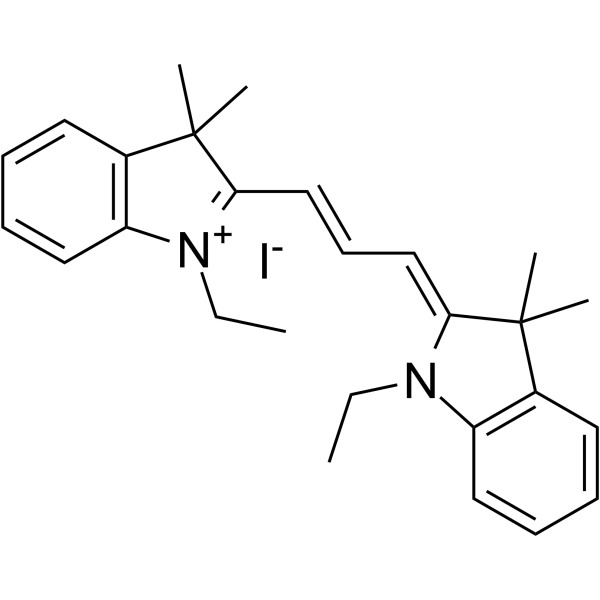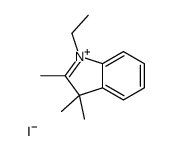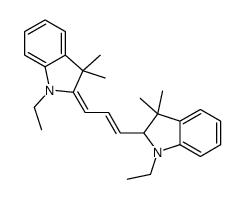14696-39-0
| Name | 1,1'-diethyl-3,3,3',3'-tetramethylindocarbocyanine iodide |
|---|---|
| Synonyms |
1,1'-Diethyl-3,3,3',3'-tetramethylindocarbocyanine Iodide
diic2(3) 1,3-Bis-(1-aethyl-3,3-dimethyl-3H-indol-2-yl)-trimethinium,Jodid 1,3-bis-(1-ethyl-3,3-dimethyl-3H-indol-2-yl)-trimethinium,iodide Astrophloxine N,N'-Diethyl-3,3'-tetramethylindocarbocyanine iodide Astrophloxin DILC2(3) 1-Ethyl-2-[3-(1-ethyl-1,3-dihydro-3,3-diMethyl-2H-indol-2-ylidene)-1-propen-1-yl]-3,3-diMethyl-3H-indoliuMIodide SNC 2 |
| Description | Astrophloxine is a fluorescent imaging probe capable of targeting antiparallel dimers. Astrophloxine can be used to detect aggregated Aβ in brain tissue and cerebrospinal fluid samples of Alzheimer's disease (AD) mice[1]. |
|---|---|
| Related Catalog | |
| Target |
Antiparallel dimer[1] |
| In Vitro | Astrophloxine binds Aβ dimers with stronger fluorescence intensity (A.U.) than binding Aβ monomers[1]. Protocol for CSF analyses[1]: 1.Prepare 1 μL of CSF samples with 1 μL of 10X protease inhibitors and diluted the mixture with 8 μL of binding buffer. Binding buffer (0.1 M sodium phosphate, 0.15 M sodium chloride, 10 mM EDTA; pH 7.2). 2.Dilute Astrophloxine to 0.5 μM with binding buffer. 3.Add individual samples and dye to the wells of a 96-well half-area black microplate with a sample to dye ratio of 1:3. Detect at λex=540 nm/λem=570 nm. |
| In Vivo | Astrophloxine shows more fluorescence (A.U.) in APP/PS1 mice CSF rather in WT mice, and is able to indicate soluble Aβ oligomers in CSF and insoluble plaques in brain tissue[1]. |
| References |
| Molecular Formula | C27H33IN2 |
|---|---|
| Molecular Weight | 512.46900 |
| Exact Mass | 512.16900 |
| PSA | 6.25000 |
| LogP | 3.36830 |
| Hazard Codes | Xi |
|---|
|
~91% 
14696-39-0 |
| Literature: Peng, Zheng-Hong Journal of Materials Chemistry, 1996 , vol. 6, # 4 p. 559 - 565 |
| Precursor 2 | |
|---|---|
| DownStream 1 | |


